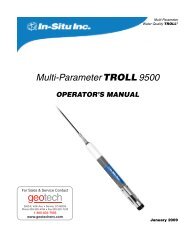TEST INSTRUCTIONS - Geotech Environmental Equipment
TEST INSTRUCTIONS - Geotech Environmental Equipment
TEST INSTRUCTIONS - Geotech Environmental Equipment
Create successful ePaper yourself
Turn your PDF publications into a flip-book with our unique Google optimized e-Paper software.
Phosphorus in natural waters and wastewaters occurs almost exclusively in the<br />
form of orthophosphates, condensed phosphates (pyro-, meta- and other<br />
polyphosphates) and organically bound phosphates. Phosphates may be added<br />
in small amounts to water supplies during treatment. Larger amounts are<br />
introduced to water used for cleaning or laundering, as components of<br />
commercial cleaning preparations. Phosphates are used to treat boiler water<br />
and are components of agricultural and residential fertilizers. Phosphorus is an<br />
important nutrient for aquatic plants. The amount found in natural water is<br />
generally not more than 0.1 mg/L unless the water has become polluted from<br />
wastewater sources or excessive drainage from agricultural areas.<br />
APPLICATION: Boiler, cooling, and industrial water.<br />
RANGE: 0.0–100.0 mg/L Total Phosphorus as phosphate<br />
METHOD: Pretreatment of the sample with heat and acid provides<br />
conditions for the hydrolysis of condensed inorganic<br />
phosphates. Heat, acid and persulfate convert the organic<br />
phosphates to orthophosphate during digestion.<br />
Orthophosphate reacts in acidic conditions with ammonium<br />
vanadomolybdate to form vanadomolybdophosphoric acid.<br />
The resulting yellow color is proportional to the<br />
SAMPLE<br />
HANDLING &<br />
PRESERVATION:<br />
concentration of orthophosphate.<br />
Rinse sample bottle with 1:1 hydrochloric acid followed by<br />
deionized water. Do not use phosphate detergents. If the<br />
sample can not be analyzed immediately, the sample should<br />
be preserved by adjusting the pH to 2 or less with<br />
concentrated sulfuric acid and refrigerated at 4°C. Warm the<br />
sample to room temperature and neutralize with 5.0 N<br />
sodium hydroxide before analyzing.<br />
INTERFERENCES: Large amounts of turbidity may interfere. Silica and arsenate<br />
interfere only if the sample is heated. Arsenite, fluoride,<br />
thorium, bismuth, molybdate, thiosulfate, and thiocyanate<br />
cause negative interference. Ferrous iron concentrations<br />
above 100 ppm will interfere.<br />
Phosphorus, Total–HR 2/3 Smart2 <strong>TEST</strong> PROCEDURES 2.04

















